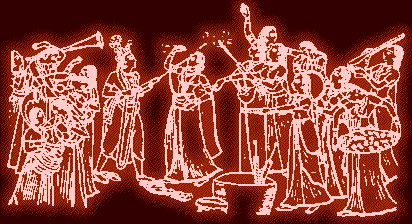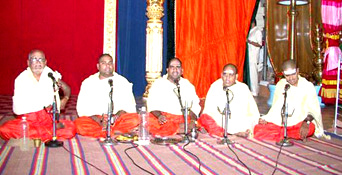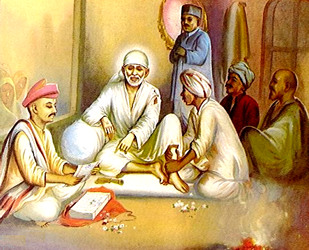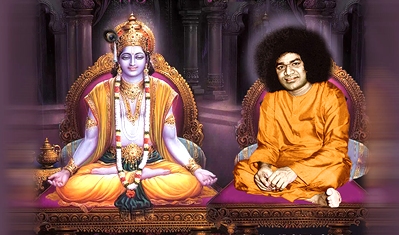|
To: |
 |
To: |
![]()
![]()
![]()

As learnt at
the Lotus Feet of Bhagavan
by
N. Kasturi (1897-1987)
![]()
![]()
![]()
![]()
![]()
![]()
PART-IV
tad
viddhi pranipâtena We are
already "that"; what the arena can confer on us is
mere freedom from the fog that hides us from ourselves.
While Swami was at Shirdi in the form He had
chosen for His previous sojourn on earth, a devotee named
Nanasaheb Chandorkar, was, one day, sitting at His
feet, gently stroking them all the while muttering the
verses of the Bhagavad Gîtâ. He was a
well-read scholar who had mastered many learned
commentaries on that divine dialogue between
Lord Krishna and His disciple, Arjuna. The
Sai Baba evinced a curiosity to know the chapter and
verse, Nanasaheb was reciting at that moment. It was
verse 34 from Chapter 4. Instead
of "the (rhyming with hay) "the
jñânam" grammar permits the version,
"the ajñânam." The meaning will then
be, "instructs 'to you, ignorance', instead of the
time-honored" instructs 'to you, wisdom'! Baba said that
critics and commentators, grammarians and dialecticians,
including Sankara had overlooked this obviously
correct reading. Baba clarified that wisdom,
jñâna, cannot be taught or learned,
communicated or conveyed through words. One can be taught
only the nature and the slippery nuances of ignorance and
the method by which it dulls, diverts and deadens the
intellect. Baba said that ignorance is not an impregnable
barrier or formidable hurdle. One need not be freed from
the region of darkness into the region of light. Darkness
is not a presence. It denotes only an absence. "A-jñâna
denotes only the layer of dust on the mirror, the veil of
ash on the cinders, the patch of moss on a sheet of
water, the cataract on the eyes, the
mâyâ on the mind," Baba explained.
Remove the veil, the dust, the ash, the moss, the myopia
of mâyâ, the
jñâna, that you are, will shine as
bright as ever. The many will vanish, the One, without a
second, will fill the Awareness. yaj
jnâtvâ na punar moham Verse
35 assures us that "one will immediately perceive all
beings from the cosmic person down to the cornstalk in
one's own self, that is to say, in the eternal
absolute". s'raddhâvâl
labhate jñânam Verse
39 describes that awareness, jñâna,
as parâm s'ântim,
Prasanthi,
Supreme
Peace.
"The mind gathers the dust on the outer side of the
glass chimney of the lamp and allows the soot to cling to
the inner side. As a consequence, the flame is
unrecognised and darkness prevails. Scrubbing is called
for. It can be done by constant repetition of the name of
God or meditation on His Form," Swami says, He
compares it to the drill which, with its persistent 'dig
dig dig', contacts the fresh-water-sea which lies under
the rocks. The sense can be rendered incapable of
mischief, the mind can be turned towards the inner
reality and the intellect disinfected against prejudice
and pride, by the practice of meditation. The
emphasis in the Gîtâ is all on control
of the senses, fearlessness, serenity, restraint over
thoughts etc. We have to take note here of the severe
condemnation by the Lord of "terrible austerities not
enjoined or advised or by scripture, which promote
hypocrisy, egoism, lust, passion and power"
[B.G.
ch. 17:5-6]
Lord Krishna says, "They torture the organs and limbs
of the body and harass Me, resident in their inner realm
(karsayantah sarîra-stham)." Breathing must
become spontaneously slow and measure, the intake, the
retention and the outflow happening without effort. When
thought is concentrated on God, felt as truth, goodness
and beauty, agitation ceases, ego lies low, emotions fade
away, passion perishes, and the breath is
discipline. Swami
is against forceful suppression or tyrannical domination,
for, He knows that our reality is soft and sweet,
harmonious and tolerant, wise and loving. It will wilt
when exposed to harshness or hurry. Those who have been
lured by the spell of certain drastic and dramatic
schools of Yoga like Hatha
Yoga
(involving the practitioners in breathing exercises) are
gradually weaned away by Swami into adopting normal and
natural schedules. During one discourse, He spoke of a
jinn which appeared before a magician as soon as he
uttered a formula. It demanded that the master keep it
bushy with some assignment or other, for, as soon as one
work is accomplished and there is no second to keep it
engaged, itwould gobble up the magician himself. The poor
fellows was at his wit's end and in mortal dread, for the
devil completed the toughest job in a trice. In despair,
he devised a plan to escape from the maw of the monster.
He planted a tall pole and ordered the demon to climb up
and, as soon as it reached the top, to slide down. It had
to repeat this barren gymnastics, until asked to stop. It
exhausted the poor devil so pitiably that it surrendered
to the master, promising unquestioning obedience, and no
gobble. Swami elaborated on the underlying lesson of this
story. The mind is the demon, that can never be quiet. It
is a tool designed and donated to us but it has usurped
the role of our master. "Do not allow it to roam and
ruin as the whim dictates". When
Arjuna was granted the vision of the cosmic power who
projected for His own delight the worlds with their
components, he was so terrified that he wanted Krishna to
appear, as the saints describe Him, with four arms,
holding the insignia of divinity. But, Krishna knew that
even that milder form would create distance and dread.
So, He resumed His human form, the charming embodiment of
love and compassion, the pleasing personification of
wisdom and power [see B.G.
ch 11].
Swami
too, when Arnold Schulman dared ask Him, "Are
you God" replied that he could never adore,
appreciate or acknowledge God if He appeared before him
in the form which man has pictured or prescribed. "How
can a fish understand the sky" He asked. It can
understand only water. "If I had come as
Nârâyana with four arms, they would have put
me in a circus, charging money for people to see me. If I
had come only as a man like every other man, who would
listen to me? So, I had to come in this human form, but
with more than human powers and......
wisdom". Krishna
advised Arjuna ... "picture God with body, senses
and mind, like Me, a body can be present anywhere I will
to be, senses that can see, hear, smell and touch
everywhere and a mind that can, by a mere thought, form,
reform, or transform, all that has emerged from Me and
has to merge in Me. Picturing Me thus, let them worship
Me, without allowing the mind to deviate from that
sâdhana. If they find themselves incapable
(asamartha) of even such effort, let them not lose
heart; let them persist in doing works for My sake, for
fulfilling My commands and reaching the goals I
prescribe. If they feel they are powerless (asaktha) to
attempt this steadfastness in adoration, it is enough if
they do every deed as dictated by duty and rest content,
without being elated when it succeeds or dispirited when
it fails. They can reach Me through this sâdhana
also." [B.G.
ch. 12] When an
act is accomplished, its consequence is certain to
follow. The doer awaits and judges the consequence, as
good or bad, desirable or undesirable, profit or loss. If
the original act is done out of an egoistic desire or in
pursuit of a glamorous hope, the fruit will have a bitter
or sweet impact on the mind. If, however, the act is done
as an expression of one's inner nature or as the
articulation of one's conscience, one's serenity will not
be shaken at all; one's
Prasanthi
will be unaffected. As Sai
Baba taught Nanasaheb
at Shirdi, Prasanthi
is our truth. Mâyâ is half-truth, for
it superimposes on the One, the falsehood of the Many. A
length of rope lying on the road in the dusk is taken to
be a snake, a garland, a crooked stick or a strip of
cloth, as the mind of man imagines (creates images) the
basic rope to be [see also S.B.
4.22:38
& 10.14:25].
A half-truth very often degenerates into a double lie.
With a little care, the false half of
mâyâ can be denied and destroyed.
Dhyana (meditation) or the upadesh
(initiation) from a Guru or the kataksha
(glance of grace) from the Avatâr can
dissipate the cloud of ajñâna
(ignorance, stupidity). Spiritual
exercises have to be adopted much more sincerely than
secular ones, because the obstacles are more formidable.
Once when some one wailed "I have been practising intense
meditation since fifty years, Swami! I have yet to gain
concentration," Swami said, "This is a shameful
confession." For, as He explained, the man had not
readied himself for the adventure of dhyana by
mastering the six preliminary steps. The first step is,
He said, "the control of the sense; the second is the
taming of the emotions, impulses and passions; the third
is the acquisition of balance and equipoise; the fourth
is the regulation of the breath; the fifth is the
prevention of external and objective impacts on oneself;
the sixth is one's pointed attention on one's progress.
Without climbing these six rings of the spiritual ladder,
dhyana would be a futile exercise. You cannot hop
in one leap to the seventh, the landing - and therefrom,
move on to the eighth, the realisation of the reality."
Dhyana is not textbook formula. It is not a rigid
time-table or a mechanical routine of staring at the tip
of the nose or breathing through alternative nostrils. It
is an enthusiastically accepted discipline, involving
sublimation of the senses, canalisation of vital energy
and orientation of the imagination. This is the reason
why Swami declares that dhyana cannot be confined
in a curriculum. During
the All India Conference of Devotees (1970) held
at Prasanthi
Nilayam,
Swami replied to questions placed before Him by the
delegates. Swami responded to one such as follows: "There
is a suggestion mentioned in a note handed over to me by
a delegate - regular classes in dhyana may be held
for devotees in Prasanthi
Nilayam,
so that the trainees can spread the sâdhana
of dhyana all over the country. I laughed when I
read this suggestion. Can anyone train another in
meditation? Or, claim the authority to train? It may be
possible to teach a person the pose, the posture, the
disposition of the hands and palms, the legs and feet,
the back, the neck and head, the style of breathing and
its frequency and speed. But, meditation is a function of
the inner man; it involves deep subjective quiet, the
emptying of the overcrowded mind and nourishing the spark
of love into an all-comprehensive light." Swami
referred also to another question presented by another
delegate. "What I am about to say in answer to another
question might pain some of you. But, the truth must be
told. There are some who are attracted to various systems
and methods of dhyana, recommended by
Hathayoga, Kriyayoga, Rajayoga etc.,
which claim to help you to realise the self. I must tell
you that no one of them can help you reach the goal. They
may improve your health or prolong life by a few more
years. But that is all they can do. What good do you
expect to achieve with that body in those extra years?
When love is absent, those years will only weigh on you.
If love is cultivated, then, the body can be used for
serving others, with no concern for the interests of the
self." In
fact, they should not be so neglected, for, they are not
sheep in sheep's clothing: they are 'lions deluding
themselves into bleating and believing that they are the
vesture they wear, a vesture they have themselves
knitted, purl by purl, through life after life. They are
âtmâ, caught inside the cocoon they
have spun laboriously around themselves. But they
identify themselves with the cocoon body, the clothing
which can be put on and put off. They doubt, they
dispute, they deny their reality. Oh! the pity of
it. Swami
says "When you believe yourself, you are really
believing God, for you are God". How can billions of
cells, each under a sentence of birth-growth-death,
operate together to sustain and protect to the utmost,
this amazingly complex body with its own needs of birth,
growth and death? The organism needs an organisation, the
organisation needs an all-knowing organiser, present
always and everywhere. "My me is God", exclaimed a
saint. When mankind discovers it has lost its way, and
reached the brink of disaster, the prayer arises from a
million hearts, Swami
is the embodiment of the consciousness that energises the
infinite cosmos, the One, which science is seeking with
intermittent success and which religion seeks and sees as
energising the infinitesimal too. Swami leads us to the
awareness of the One, in all ideas, ideals, objects,
objectives, waves and particles. He has come to teach the
Truth of Unity, for that Truth alone can free us from
fear and the death it breeds. Swami teaches us to picture
every sentient and non-sentient thing as trekking "back
home", back to the source, back to the Cosmic Will that
willed them all. He has come to enthuse the homesick, to
strengthen their limbs, to reinforce their resolve, to
smoothen their path - all paths that lead homeward and to
welcome the innocent, the injured, the prodigal and the
pure into the Home, Himself. Swami
is the great reconciler. He reveals to us that the many
we think we are, are all only One. To those who fight
against each other waving holy books and flags, He
declares that every religion is a facet of the same
Truth. The devotionally minded in all lands and of all
races pray in many languages to the same God. The
rationally inclined use different tools of logic to probe
into the same Reality. They express their findings or
failures in many dialects, but they all reveal the
Incomprehensibility of the same God. The action-prone
discover behind the masks, worn by those whom they
worship through service - the deprived, the distressed,
the diseased, the desperate - the face of the God they
adore. Though the faces have different forms and
features, they are all of the same God. The three
directions in sâdhana for union with the
source (yoga) are known as Bhakti Yoga,
Jñâna Yoga and Karma Yoga. The
Raja Yoga (respiratory regulation for purification
of the mind) and Hatha Yoga (acquisition of
mastery over respiratory, muscular, nervous and
circulatory systems in order to isolate the Self from its
material appurtenances) are, according to Swami, to be
carefully communicated personally to aspirants with
requisite mental and physical equipment only. Composition
photo by Kouwshik, Sri
Lanka

PART-IV
paripras'nena sevayâ
upadekshyanti te jñânam
jñâninas tattva-dars'inah
[B.G.
4:34]
tat
-- that knowledge of different sacrifices; viddhi -- try
to understand; pranipâtena -- by approaching a
spiritual master; paripras'nena -- by submissive
inquiries; sevayâ -- by the rendering of service;
upadekshyanti -- they will initiate; te -- you;
jñânam -- into knowledge;
jñâninah -- the self-realized; tattva -- of
the truth; dars'inah -- seers.
Know
'That' by prostration,
by inquiry, by service,
the wise will instruct you,
for they have 'seen' the "That ness".
![]()
![]()
![]()
![]()
![]()

![]()
![]() " Taittirîya Aranyaka
"
" Taittirîya Aranyaka
" ![]()
Vedic
chanting
![]() This
and That
This
and That
![]() The Shirdi
Scholar
The Shirdi
Scholar

evam yâsyasi pândava
yena bhûtâny as'eshâni
draksyasy âtmany atho mayi - [verse 35, chapter
4]
tat-parah samyatendriyah
jñânam labdhvâ parâm
s'ântim
acirenâdhigacchati - [verse 39, chapter
4]![]() Flame
with no Flicker
Flame
with no Flicker

![]() Dhyana and the
Nose
Dhyana and the
Nose
![]() Mind
the Mind
Mind
the Mind
 But,
Soham is tainted with a trace of duality, of a
concept of two (He and I). Swami exhorts us to inhale
"He" - "So", with every breath and exhale or eliminate
"I" - "Aham" with every breath. This is, according to
Him, the very purpose of alternate intakes and outgoings.
Verse 29, Chapter IV of the Gîtâ refers to
persons who 'sacrifice' the inward vital tendency in the
outward and the outward in the inward and thus counter
the tendencies towards opposites. The result achieved is
the reciprocal equalisation of life-breaths. 'He' merges
in 'I', 'I' merges in 'He' and the One is experienced,
with no shade of a second. "I am in you; you are in
Me. We cannot be separated," declares Swami. The
mergence is the yajña, the valedictory
victory of the life. When that is consummated, there is
neither So nor Aham. Soham casts
away the vesture of duality and shines in the unique
glory of OM. Meditation on Om is meditation
on the Absolute.
But,
Soham is tainted with a trace of duality, of a
concept of two (He and I). Swami exhorts us to inhale
"He" - "So", with every breath and exhale or eliminate
"I" - "Aham" with every breath. This is, according to
Him, the very purpose of alternate intakes and outgoings.
Verse 29, Chapter IV of the Gîtâ refers to
persons who 'sacrifice' the inward vital tendency in the
outward and the outward in the inward and thus counter
the tendencies towards opposites. The result achieved is
the reciprocal equalisation of life-breaths. 'He' merges
in 'I', 'I' merges in 'He' and the One is experienced,
with no shade of a second. "I am in you; you are in
Me. We cannot be separated," declares Swami. The
mergence is the yajña, the valedictory
victory of the life. When that is consummated, there is
neither So nor Aham. Soham casts
away the vesture of duality and shines in the unique
glory of OM. Meditation on Om is meditation
on the Absolute.![]() Step by Step
Step by Step
![]() Free
from Formula
Free
from Formula
![]()
![]() The Guru
The Guru
![]()
"Lead me from this fleeting unreality to everlasting
reality.
Lead me from this deceptive darkness to all-revealing
light.
Lead me from this inexorable death to inherent
immortality.
When the cosmic consciousness receives the impact of
these vibrations, and when there is a sad dearth of
Gurus who can respond and lead, It concretises
Itself (though Its own Will) as the Avatâr."![]() The
Avatâr
The
Avatâr
![]()
(1) lay down the guidelines for rigtheous living in the
world as it has shaped itself
(2) allay the conflicts and hatreds that rend people as
under,
(3) console, comfort, and protect the good and godly who
are oppressed by the wicked and the wily,
(4) reveal the true message of the scriptures which has
been obscured by commentators and propagators,
(5) relieve the earth of the burden of vice and
(6) redeem the pledge conveyed in past ages that I shall
appear as the Savior.
Swami has also proclaimed that He has resolved to assume
the role of a Teacher of Truth (Sathya Bodhakaya)
and that Love is the lesson which teaches Truth. He is
Love, He can be won through Love, He accepts Love and
rewards Love.
![]() I and I are I
I and I are I
![]()
![]()
![]() " Ârati - Lightoffering
"
" Ârati - Lightoffering
" ![]()
Text
Ârati